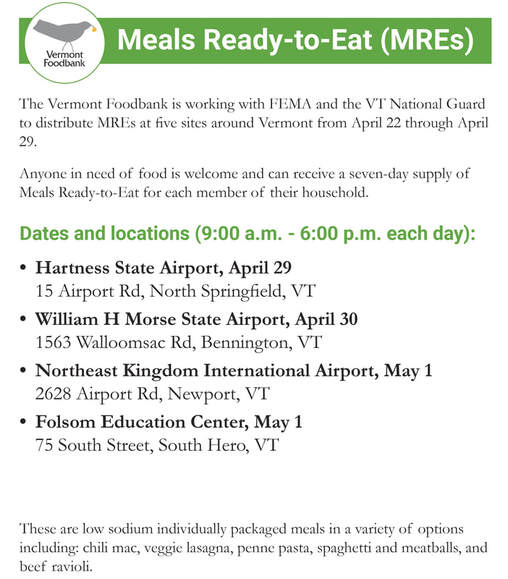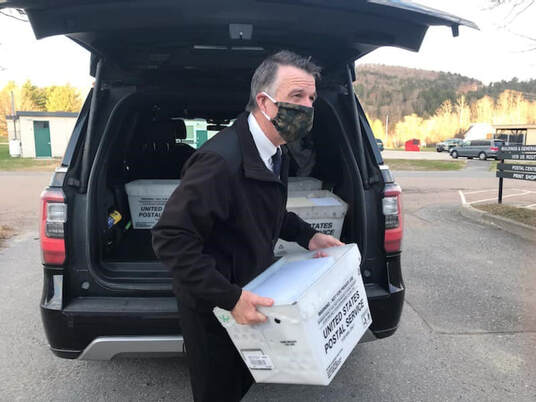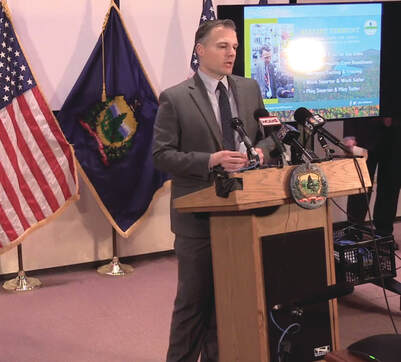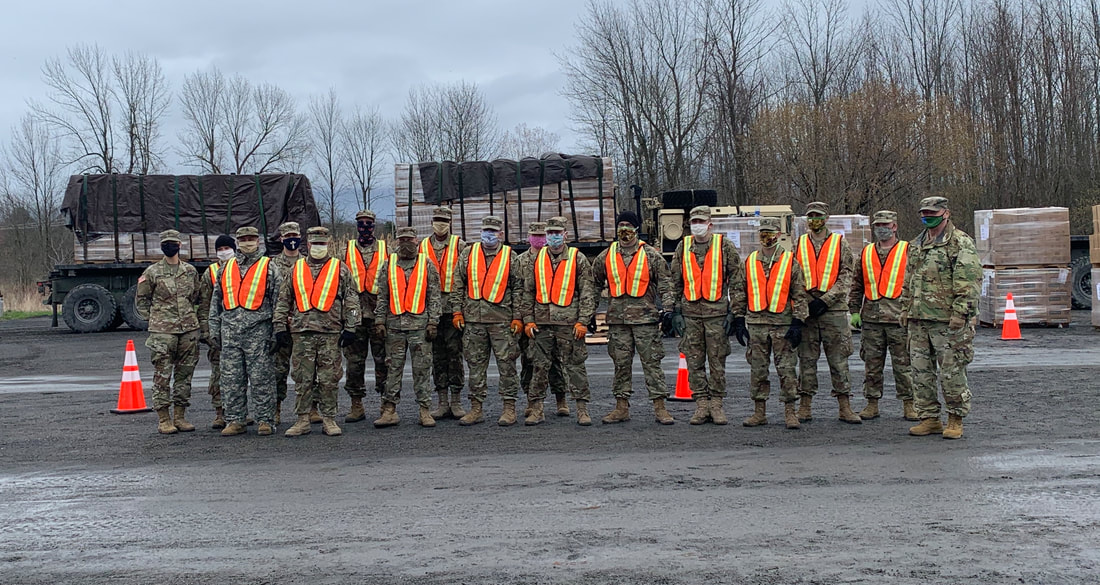 VT Air National Guard F35 fighter jets left contrails all over the morning sky above the Islands while flying maneuvers last Thursday. Photo by ROB SWANSON, Islander Photojournalist VT Air National Guard F35 fighter jets left contrails all over the morning sky above the Islands while flying maneuvers last Thursday. Photo by ROB SWANSON, Islander Photojournalist By MIKE DONOGHUE Islander Staff Writer SOUTH BURLINGTON -- The 158th Fighter Wing of the Vermont Air National Guard will honor front line COVID-19 responders and essential workers in the state with a flyover throughout Vermont on Friday. A formation of four F-35 aircrafts will be in the Franklin, Grand Isle and Chittenden County area for about 10 minutes starting shortly after 1 p.m., the guard said. All times are approximate. The F-35A Lightning IIs will take off at noon from the Vermont Air National Guard Base in South Burlington to begin its 90 minute flyover. The flyover is part of Operation America Strong, an Air Force effort to salute healthcare workers across the country. “Our healthcare professionals, emergency responders and essential workers have served on the frontlines of this pandemic, putting the health and safety of their neighbors above their own and I cannot thank them enough for their commitment and service,” Governor Phil Scott said. “They’ve worked long, hard hours and given so much throughout this once-in-a-century crisis. They are heroes to us all,” Scott said. Doctors, nurses, other health care workers, first responders, store clerks, media members and others have been on the front lines in Vermont since the deadly COVID-19 scare began in March. “On behalf of the Air Force and the Vermont Air National Guard, we are proud to recognize and pay tribute to our healthcare professionals, essential personnel and first responders throughout Vermont,” said Col. David “Caesar” Shevchik, Commander of the 158th Fighter Wing. “This flyover is in honor of their professionalism, selfless service and commitment to our state and citizens when we need them most,” Shevchik said. The F-35s will go down the western side of Vermont over Middlebury, Rutland and Bennington, head east to Brattleboro, where they will head north. The aircraft will go up the eastern side of Vermont flight path over White River Junction, to Randolph, Berlin and Morristown. The Green Mountain Boys will head to St. Johnsbury and Newport before turning west for St. Albans. The flight path will likely take the F-35s through the Champlain Islands from St. Albans and down the west side of the state to the Burlington area before landing about 1:30 p.m.. Vermonters are reminded to maintain all social distancing guidelines and refrain from traveling to local hospitals or gathering in large groups to view the flyover.
0 Comments
 By MIKE DONOGHUE Islander Staff Writer MONTPELIER – Gov. Phil Scott said he is prepared this week to outline a proposed major economic recovery package for Vermont in the wake of the deadly COVID-19 pandemic. Gov. Scott also has signed a new order — Be Smart, Stay Safe — to extend Vermont’s State of Emergency to June 15. The order reflects some of the retail re-openings and eased restrictions announced in recent weeks. The Islander asked Scott if his proposal would offer anything special to Vermont’s four northern counties (Grand Isle, Franklin, Orleans and Essex), which have been hit the hardest due to prohibitions blocking tourists and others from entering along the northern border. Scott declined to give any hints about his plan. The Governor said he was aware tourism across all Vermont has been seriously impacted in recent months. Scott said as a frequent visitor to Grand Isle County, he was aware of the current challenges facing local businesses to stay viable. The Governor remained cool toward the idea of him ordering all people to wear masks in public places, but said local towns and cities were free to take that step. The city of Burlington was among those that approved a local ordinance on Tuesday evening. He also said it would be up to local stores and businesses to change those frequently displayed signs “No shoes, no shirts, no service” to add a line for “No masks.” Scott said he would not require the masks. Those requirements for shoes and shirts have nothing to do with the state of Vermont, according to Ben Truman, a spokesman for the Vermont Health Department. In other talking points, the state indicated statistics show the spread of COVID-19 continues to slow and Vermont had one of the lowest 3-day and 7-day growth rates in the country. The Governor and Health Commissioner Mark Levine continue to say Vermont must also consider neighboring states where the virus is much more prevalent and outbreaks are still occurring. Levine noted that over the weekend in nearby Clinton County in New York officials reported nine new cases and 27 close contacts — as a result of parties in Plattsburgh, N. Y. “Not following guidelines can fuel the virus’ spread in a single instance,” Dr. Levine said. Natural Resources Secretary Julie Moore also is encouraging residents to stay within the state and visit little known Vermont Parks and Recreation facilities. She urged people to stay away from popular sites like Burlington’s North Beach or the Waterbury Dam and to travel on little known backroads for recreational opportunities. Scott’s newest order allows for limited resumption of marinas and lodging facilities, including hotels, motels, bed and breakfasts, inns, short term rentals, parks for recreational vehicles and campgrounds. Those also include those managed by the Vermont Parks and Recreation Department. These facilities can open May 22 for Vermont residents only, or for those who have met the 14-day quarantine requirement. They also will be subject to strict health and safety standards and guidance from the Agency of Commerce and Community Development. Gov. Scott also hinted that the state’s limit on gatherings, now set at 10 people, could soon be expanded to 25.  By MIKE DONOGHUE Islander Staff Writer MONTPELIER -- Vermont has 78 cases of out-of-staters, including 49 people from New York State, testing positive for the deadly COVID-19 virus, according to the Vermont Health Department. The out-of-state numbers were provided to The Islander in response to multiple requests after several questions were raised about conflicting statistics for town and county figures being provided to Vermonters. The Health Department did acknowledge that the positive out-of-staters were assigned to Vermont counties – apparently where the person was tested. The Coronavirus disease 2019, abbreviated as COVID-19, is the name for the pandemic that first started to affect people in Wuhan, China in December 2019. The mild to severe respiratory illness was first reported in Vermont in March. There have been 929 positive cases with 53 deaths in Vermont. The state has recorded 21,676 tests with five people still hospitalized and 12 more under investigation at a hospital, the health department said Wednesday. There have been eight positive cases in Vermont from people from New Hampshire and Massachusetts, the Health Department said. Also there have been six positives tests from people that the Health Department said had unknown residences. As of Tuesday evening 849 of the 927 cases reported in Vermont were residents, the state Health Department said. The 927 cases also include Vermonters that are temporarily living out of state and have tested positive. These could include winter snowbirds, temporary workers and students. Racial incident complaint The issue of out-of-staters was front-and-center as Gov. Phil Scott started his news conference on Wednesday. The Governor reported Vermont State Police are investigating a complaint of possible racial bias for a comments made to a New York family that moved to Windsor County a few months ago. Gov. Scott said he called the father to offer an apology for the incident reported near the victim’s residence in Hartford on Friday. The Governor said the victim reported he was told that he did not belong in Vermont and that the Governor did not want the family there. “This is not OK,” Gov. Scott said. State police said the victim was driving near his residence in Hartford in his vehicle, which has New York registration plates, when two unknown vehicles, possibly pickup trucks, approached him and flagged him down. The victim, thinking someone needed assistance, stopped and spoke with a white man. The victim, who is black, was advised he was not wanted in Vermont and told to leave. There were significant racial undertones to the interaction, police said. The victim, whose 11-year-old son was with him in the vehicle at the time, said he was in fear for their physical safety, police said. He was able to verbally deescalate the situation and drive home. No physical altercation occurred, police said. “We can be neighborly and compassionate and still stay safe,” Gov. Scott said. He noted while Vermont tourism is limited now, those with family here or who must travel, are welcome. “This virus cannot be used as an excuse for bigotry or hatred,” he said. “The common enemy is the virus, not each other.” Out-of-staters are asked to quarantine for 14 days, but the Vermont borders are not closed. Traffic is free to move in and out. The state police is investigating with help from Hartford Police and Chief Phillip Kasten. The name of the victim and family are being withheld for the time being due to safety concerns, police said. Capt. Garry Scott, the state police director of fair & impartial policing and community affairs, has been in contact with the victim and his family for several days. By MIKE DONOGHUE
Islander Staff Writer Golf courses can have limited re-openings for Vermonters, but campgrounds, marinas and beaches are expected to remain closed under statewide COVID-19 orders, Gov. Phil Scott said last Wednesday. The news at Scott’s new conference was not good for Grand Isle County, which relies heavily on sports enthusiasts, tourists and day trippers to fuel the local summer economy. “Campgrounds, marinas and beaches shall not be opened at this time,” Scott wrote in his latest directive, which went into effect on last Thursday. His new directive “Play Smart and Play Safe” updates his original “Stay Home, Stay Safe.” Scott acknowledged marinas have been open in recent days to help launch boats. That was allowed when the state allowed certain work sites to have two-member crews return to their jobs. However, Scott said his latest Executive Order still wants the full marina businesses to remain closed. Under questioning by The Islander, Scott did say that he believed that “in the next week or so” campgrounds and marinas could be opened in some format. In the meantime, state and private campgrounds must remain shut. It was unclear when beaches and swimming pools would be approved. Scott said it was important for Vermont to pace itself and not take too many steps at once. The Governor also gave the green light for small groups of Vermonters leaving their homes for outdoor recreation and fitness activities with low or no direct physical contact. He said inter-household socializing also can now begin. He suggested members of one household may gather – and allow children to play – with members of another trusted household. The second home can be another relative or a trusted neighbor that has been following the health guidelines. The group of 10 or less must follow the usual health and safety precautions now in effect, Scott said. Vermonters age of 65 or older, as well as those with pre-existing health conditions, are recommended to remain at home for the time being, Scott said. The Governor said he does prefer the social interactions and gatherings be outside to ensure greater physical distancing. The Governor and Agency of Natural Resources Secretary Julie Moore were hesitant to allow organized youth sports for basketball, Little League, softball or other youth activities. Adult recreation leagues also are out. Moore said playing toss in a field or working on athletic skills are acceptable with small numbers. During Scott’s news conference, which is broadcast live on three TV stations and available on local access TV, Moore urged people to avoid popular sites and go to less known, less populated locations. Moore told Vermonters to avoid several high profile attractions, including two major tourists attractions for the Champlain Islands: the Sand Bar State Park on the Milton/South Hero town line and the Colchester Causeway, which is used by bicyclists, runners, and walkers to get to South Hero. She did note that fishing is one activity that allows for social distancing and can be done with friends. Golf and More The new guidelines urge Vermonters participating in outdoor recreation and fitness activities to “arrive, play and leave.” There should be no congregating before or after activities, including no tailgating, Scott said. Scott said both signs and new registration procedures should be adopted that reinforce outdoor facilities are open only to Vermonters and those who have met the 14-day quarantine requirement. He also said golf courses should eliminate services or transactions that result in touch points and/or staff-customer interactions that are not absolutely necessary. Recreational sites also need to reduce high contact surfaces and common areas, including closing waiting areas, removing picnic tables, closing play structures, and offering only rental equipment that can and will be thoroughly disinfected between users. Facilities are urged to close pro shops, lobbies, bars and restaurants that encourage congregating of people and personal contact. In some cases, curbside pick-up or delivery could be instituted. Restroom facilities may be opened only if they can be regularly cleaned and disinfected. By MIKE DONOGHUE, Islander Staff Writer
MONTPELIER -- Gov. Phil Scott has authorized a gradual reopening of retail businesses with strict rules starting Monday, May 18. Retailers will be mandated to limit customers and staff to up to only 25% of the maximum legal capacity at their shops and stores. The rules are designed to address safety issues in the wake of the deadly COVID-19 pandemic in Vermont. Other safety rules will be in place, including requiring all employees to wear masks, Scott said. During his news conference, Scott declined to mandate customers wearing face coverings while inside a business. Scott, under questioning, also was cool toward an idea about allowing businesses to impose a 10 percent surcharge for customers that refuse to wear masks in the stores. The money could be used directly for low-paid store clerks or to help pay hazardous duty pay that the state has proposed for certain front line workers. Retail shops have to maintain the 6-foot social distancing rule and also conduct health and safety training for their employees, Scott said. The Agency of Commerce and Community Development is working on developing health and safety guidelines. Still unknown is the future for a large segment of the economy for the Grand Isle County region. There is no word on the full openings for restaurants, lodging facilities, campgrounds, entertainment venues, marinas, recreational sites and other commerce. The region depends on the summer tourist trade, but may not see many people heading to the Champlain Islands in the coming months. The state has given the green light for summer day camps to operate, but the futures for those sites remain unclear as organizers try to determine the best way to keep children safe. Several overnight camps, which also help bring tourist dollars to the area, have announced plans to cancel in-person programs for this summer. Dr. Mark Levine, state health commissioner, remained unable this week to provide any statistics on how many out-of-staters have tested positive for COVID-19 in Vermont. These numbers could include tourists, employees from out of state firms on assignment to Vermont, college students, relatives visiting families for extended periods and others. The Department of Financial Regulation, which makes projections about the Vermont pandemic based on Health Department statistics, also has been unable to provide the numbers it is using to make the modeling. The state likewise has been unable to give the numbers of Vermonters that have tested positive out of state for COVID-19 in recent months. That would include winter snowbirds, college students, workers temporarily assigned out of state and others that may have returned home or are headed here. Gov. Scott emphasized he wants to take a cautious approach. Scott said he does not want Vermont to have to backtrack. In Colchester last weekend the Vermont Health Department collected 138 samples from childcare providers, first responders – police, fire and rescue – and health care workers. However, during the Governor’s news conference on Monday, a Franklin County newspaper owner, who also is a volunteer firefighter, reported his hometown information was never collected – only a post office box number. Greg Lamoureux of the County Courier said some Vermont towns like Georgia have no zip codes so any positives tests are likely showing up in St. Albans or Milton, which would provide a false report to the county. He said some towns, including Enosburg serve multiple towns so the local numbers remain suspicious. Scott also agreed to allow childcare centers to reopen Monday June 1. They also must follow safety guidelines from the state. Education Secretary Dan French also reported that there are still no large end-of-the-year in-person gatherings. Virtual gatherings online would be permitted. Those would include sports banquets, senior proms, baccalaureate services and graduations.  A member of the Vermont National Guard carrying MRE's to a vehicle Friday. Each box contains 16 ready to eat meals. A member of the Vermont National Guard carrying MRE's to a vehicle Friday. Each box contains 16 ready to eat meals. By TONYA L. POUTRY, Publisher/Editor SOUTH HERO - The Vermont National Guard held a Meals Ready-To-Eat (MRE) distribution at Folsom Education and Community Center Friday for families and individuals in need. The distribution was coordinated by the Vermont Foodbank, FEMA, Vermont Agency of Transportation and the Grand Isle County Sheriff's Department. The Vermont Department of Health was also on site offering mental health advice and services. Grand Isle County Sheriff Ray Allen told The Islander 2,304 cases were distributed at the event - 36,864 meals. The site saw residents from Grand Isle, Chittenden and Franklin counties. "The members of the National Guard and VTrans were incredible to work with. Traffic at the site flowed smoothly. The efficiency and cooperation of all agencies involved made this such a success. We appreciate all involved for supporting our community," said Allen. Over 32,000 cases of MRE's have been delivered to Vermont residents over the past two weeks -- 512,000 meals.  By MIKE DONOGHUE Islander Staff Writer SOUTH HERO -- The Vermont Foodbank will be at the Folsom Education and Community Center on Friday distributing Meals Ready to Eat (MRE) for the needy. The Foodbank will distribute the meals from 9 a.m. to 6 p.m. with help from Federal Emergency Management Agency, the Vermont National Guard and the Grand Isle County Sheriff’s Department. Anyone in need of food is welcome to stop at the South Street site. The handout is designed to help Vermonters, especially those facing financial strain due to the deadly COVID-19 virus. The Foodbank will provide a seven-day supply of Meals Ready to Eat for each member of a Vermont household. A similar distribution is planned also for Friday at the Northeast Kingdom International Airport in Coventry. Other scheduled for this week are Wednesday at the Hartness State Airport in North Springfield and Thursday at the William H. Morse State Airport in Bennington. The low-sodium meals are individually packaged with a variety of options. They include chili mac, veggie lasagna, penne pasta, spaghetti and meatballs and beef ravioli.  The update from the Vermont Department of Health shows a total of 862 positive cases in Vermont. See more at https://www.healthvermont.gov/response/coronavirus-covid-19 The update from the Vermont Department of Health shows a total of 862 positive cases in Vermont. See more at https://www.healthvermont.gov/response/coronavirus-covid-19 By MIKE DONOGHUE, Islander Staff Writer MONTPELIER -- The State of Vermont on Monday unveiled a partial, but flawed list of town-by-town statistics showing the number of positive COVID-19 cases in each community. The Vermont Health Department listed only 29 towns that have six or more positive cases. The department failed to identify the communities that had zero positive reports. Burlington, the state’s largest community, leads the way with 157 positive tests, the list notes. The state also is reporting that Swanton had 44 positive tests – placing the Franklin County community for having the third most – three ahead of Essex, the second largest community in Vermont. The problem is neighboring St. Albans Town, which hosts the Northwest State Correctional Facility with about three dozen inmates testing positive, is not included on the list of communities released. Attempts to reach the Swanton Town Administrator or the chairman of the Selectboard for comment were unsuccessful. Swanton Deputy Health Officer Lynn Billado told The Islander Monday that the state does give general daily updates, but the Franklin County community had received no word about its total positive COVID-19 tests. She was among those that theorized that a large portion of the number attributed to Swanton probably actually belong to St. Albans Town. She was surprised to learn St. Albans Town was not listed. Dr. Mark Levine, the health commissioner, had said on Friday that his department has reached out to communities with a large outbreak. The Health Department reported St. Albans City had 19 cases, but it was unclear if some positive tests from St. Albans Town could be mixed in. The state makes no mention of Grand Isle County, which reportedly has all three cases in one community. Moving down into Chittenden County, the town of Colchester ranks fourth in the state with 38, followed by South Burlington with 37 and Milton, being in sixth place, with 24. The Vermont Health Department did not provide any numbers for the deaths in each town. Some states like Connecticut have an interactive map that provides the number of cases, number of deaths and the per capita number. The Vermont map did show that some ski area towns outside Chittenden County have seen a large numbers. Those include: Stowe/Cambridge/Waterbury, Woodstock/Hartford and Wilmington/Dover. Levine’s boss, Human Services Secretary Mike Smith agreed that Vermont would take another look at the information and see if the missing data also could be provided. The 29 communities listed by the Vermont Health Department account for 570 cases out of the 855 positive tests statewide. It was unclear where the other 285 cases are located. By not providing towns with 1 to 5 positive tests, a clump of eight neighboring towns could end up with about 40 cases and Vermonters would be unaware of the problem. It also fails to meet the statistic shared by other states. Connecticut has a interactive map that shows the actual number of cases by town and the number of deaths by towns, and the per capita rate Gov. Phil Scott had said on Friday that the numbers would be rolled out on Monday. The list comes in response to ongoing inquiries by The Islander based on concerns from interested readers across three counties served by the newspaper. Readers of The Islander in the Champlain Islands, down into Milton and Colchester and also into Franklin County have been asking why the town reports have been blocked by the state. The Islander filed a formal request for the information under the Vermont Public Records Act. Dr. Levine initially cited HIPPA as a reason not to release the public information but the federal law does not apply according to a couple of legal opinions. On Monday, he also mentioned personal privacy. Levine had said earlier he thought the small populations of some towns might make it easy to identify those people with the deadly virus. Scott and Smith said they thought the numbers could be provided without a problem. Health Department spokesman Ben Truman said Friday afternoon it remains a balancing act: “transparency and our obligation to protect an individual’s private health information. LEGISLATORS HELP The House of Representatives in Montpelier launched a tool this week to assist Vermonters unable to get through to the Department of Labor to resolve issues surrounding Unemployment Insurance and Pandemic Unemployment Assistance claims. House Speaker Mitzi Johnson, D-South Hero, said it is designed to help Vermonters in need at a critical time. “Legislators are hearing concerns from Vermonters across the state about their inability to reach the Vermont Department of Labor via phone to resolve their unemployment claim issues. We are all deeply concerned that many Vermonters - many of whom live paycheck to paycheck - have gone six weeks without income. Vermonters need help now,” Johnson said. “I deeply appreciate that Governor Scott and Treasurer (Beth) Pearce jumped in last week and sent $1,200 relief checks to Vermonters who applied, but had not yet been approved, for unemployment insurance. Legislators are hearing from community members that many people are still waiting,” Johnson said. She said legislative leaders developed a plan for legislators to assist Vermonters and gather information for the overwhelmed Labor Department. She said any Vermonter with outstanding case issues can contact their state legislators. Johnson said with very basic information, the state representative can help Vermonters get through to the Department of Labor to resolve your claim issues. “We very much appreciate the Department of Labor employees and the Administration working so hard to resolve the backlogged cases. They had an impossible job from the start,” she said. Processing claims in a timely fashion is a Herculean task on a 30-year-old computer system when unemployment jumps overnight from 2% to 20%.” Legislator contact information is available at https://legislature.vermont.gov/.”  A masked Gov. Phil Scott helped deliver almost 8,400 checks to the state mailing facility Monday morning to support Vermonters who have been unable to file claims with the Vermont Department of Labor. Photo courtesy of Governor’s Office A masked Gov. Phil Scott helped deliver almost 8,400 checks to the state mailing facility Monday morning to support Vermonters who have been unable to file claims with the Vermont Department of Labor. Photo courtesy of Governor’s Office By MIKE DONOGHUE Islander Staff Writer MONTPELIER -- The Vermont state treasury issued $1,200 checks on Monday to 8,384 Vermonters because the Department of Labor failed to meet a mandatory deadline from Gov. Phil Scott to get caught up on Unemployment Insurance claims sparked by the deadly COVID-19 virus. Gov. Scott said he delivered the envelopes to the state mailing center shortly before his Monday press conference so the money can get to needy Vermonters who have been frustrated for several weeks by an inability by the Labor Department to get claims settled. A frustrated Scott had announced last Friday that if Interim Labor Commissioner Michael Harrington and his staff failed to clear by Saturday night all the pending UI claims, the state treasurer would be directed on Sunday to issue $1,200 checks for each Vermonter still waiting. State Treasurer Beth Pearce said on Monday several members of her staff worked on Sunday to make sure the checks could be issued and hit the post office on Monday. Scott made clear the $1,200 would not be considered a full payment, but rather a partial installment designed to help Vermonters cover needed expenses. Scott said the exact amounts owed each person would be sorted out in the coming weeks. Many Vermonters, hit by layoffs and the Stop Work order by Gov. Scott, have been unable to pay their mortgage or rent, buy food for their families, make installment payments for their car, buy gasoline, pay utilities and other monthly bills. The impact on each family further spreads to Vermont businesses where they work and shop. Harrington reported last Friday his department is receiving hundreds of thousands phone calls -- up to 600,000 -- per week. Vermonters have been complaining for several weeks about the inability to get connected with the Labor Department to file for unemployment compensation, to ask questions or resolve claims. Phone calls are going unanswered, placed on permanent hold or getting lost, Vermonters have reported. Harrington said he did not know how many people were represented by all the “pings.” He said some pings may include robocalls that are now blocked. The Islander and other media outlets are getting many complaints from people unable to reach the Labor Department or settle pending issues. “Getting through to claims line (is) a full time job. Literally thousands of calls and no success,” one frustrated reader wrote Friday to The Islander. “Both of us – one on cell phone and the other on land line – nonstop all day for a week. No success. Frustrating.” Harrington said on Monday a new outside contract, which could cost up to $2 million, will allow for the call center to have up to 150 people on the phone. There had been 15 call takers before COVID-19, he said. House Speaker Mitzi Johnson, D-South Hero had suggested the department use and train some of the 150 state representatives, who are getting paid, to handle some of the incoming calls or to ease the logjam. Harrington told reporters he did not act on the offer. Harrington did say state legislators are sending in cases that they have been notified and he is directing them to the intake center. During one legislative committee conference call last week, several expressed frustration with the repeated complaints from their constituents each week. As the weeks go on some frantic calls include cussing by the frustrated taxpayers, noted one legislator, who acknowledged understanding their feeling. Under questioning Harrington on Friday admitted he has not worked at the call center to hear concerns first hand from the frustrated Vermonters. Harrington also responded that he had given no thought to stepping aside in favor of somebody that might be able to better address the logjam. Except for the Labor Department, Gov. Scott and the rest of his cabinet have been getting high grades for their extra work over the past 5 or 6 weeks on the deadly COVID-19 virus.  Interim Labor Commissioner Michael Harrington addressing questions at the April 17, 2020 media briefing. Interim Labor Commissioner Michael Harrington addressing questions at the April 17, 2020 media briefing. MIKE DONOGHUE Islander Staff Writer MONTPELIER -- Gov. Phil Scott said Friday that he is going to start lifting his “Stay Home, Stay Safe” Executive Order to allow for the gradual return of small groups of employees – one or two person operations – on Monday and is working on farmers markets resuming on May 1. The first step comes as Interim Labor Commissioner Michael Harrington reported his department is receiving hundreds of thousands phone calls -- up to 600,000 -- per week. Vermonters have been complaining for several weeks about the inability to get in touch with the Labor Department to file for unemployment compensation, ask questions or resolve claims. Calls are going unanswered, placed on permanent hold or getting lost, Vermonters have reported. Harrington said he did not know how many people were represented by all the “pings.” He said some pings may include robocalls that are now blocked. The Islander and other media outlets are getting many complaints from people unable to reach the Labor Department or settle pending issues. “Getting through to claims line (is) a full time job. Literally thousands of calls and no success,” one frustrated reader wrote Friday to The Islander. “Both of us – one on cell phone and the other on land line – nonstop all day for a week. No success. Frustrating.” Under questioning Harrington admitted he has not worked at the call center to hear concerns first hand from the frustrated Vermonters. Harrington also said he has declined to take up an offer by House Speaker Mitzi Johnson, D-South Hero to have 150 state representatives, who are getting paid, to handle some of the incoming calls or to ease the logjam when they have free time. Harrington also said he had no plans to step aside in favor of somebody that might be able to better address the logjam. Except for the Labor Department, Scott and the rest of his cabinet have been getting high grades for their work over the past 5 or 6 weeks on the deadly COVID-19 virus. Scott did say he gave Harrington until late Saturday night to get the backlog resolved. If that fails, Scott said he has directed the state beginning Sunday to cut $1,200 checks for each Vermonter with an unresolved claim in recent weeks. Scott said the state will settle up later on the final claims. Scott’s plan Scott said in a news release that he has directed the Agency of Commerce and Community Development (ACCD) to issue guidance authorizing outdoor businesses and construction operations with crews of two or less and some single-person low contact professional services, such as attorneys, realtors, appraisers and others, to operate if specified safety requirements can be met. He also is giving a green light for municipal clerks that closed their government offices to resume public hours. A large number of municipal clerks have continued to do their work behind locked doors. Drop boxes for tax payments, dog license renewals and other requirements were used. Now the clerks are allowed to deal with one customer at a time, Scott said. The state’s latest study shows the growth rate in new COVID-19 cases has averaged below 4% for the last 12 days, the rate at which cases double has slowed dramatically, and the number of people requiring hospitalizations remains stable. Scott also is giving Farmer’s Markets the go ahead to resume on Friday May 1. He said the Agency of Agriculture will develop guidelines so farmers can sell their products. The governor hinted that opening weeks may not be the traditional gatherings with neighbors congregating. It may be more like curb service now offered by local general stores. The governor said the was willing to begin turning the spigot because Vermonters have taken the COVID-19 virus seriously and stayed at home as requested. “We’re seeing some promising results and continue to trend below even the best-case scenarios predicted in recent forecasting. This is all a result of the hard work and sacrifice of Vermonters across the state, and I can’t thank you enough,” Scott said. “These forecasts show we can continue to slow the number of new COVID-19 cases if we continue to stay vigilant, meaning staying home, avoiding large gatherings, staying six feet away from others, using a cloth face covering when in public and washing our hands,” the Governor added. “But what these trends also show is that with the right precautions, we can take small steps to get more Vermonters back to work and avoid a spike in cases that would put lives at risk.” Gov. Scott outlined a measured, phased approach to reopen the economy - balancing the need to improve overall social and economic wellbeing with the need to prevent a resurgence of COVID-19 outbreaks. The order, and a corresponding guidance memo from ACCD, detail specific measures for those businesses authorized to reopen to ensure continued social distancing. Applying these measures, it also clarifies guidance to allow more retail operations to operate through phone-in or online ordering, and curbside pickup or delivery. The Governor also outlined five principles, developed in collaboration with the Vermont Department of Health, the State Emergency Operations Center (SEOC), ACCD and others, which will guide the state’s Restart Vermont planning and decision-making process. They are:
“Preventing outbreaks and limiting the spread of COVID-19 is the only way to avoid future business and social disruption,” Commerce Secretary Lindsay Kurrle said in her memo to Vermont businesses. “The success of this phased restart will depend in large part on the ability of employers and employees to adhere to the public health, safety and social distancing measures essential to limiting the spread of illness.” The administration will continue to update the public on the RestartVT planning process as details and next steps are determined. |
|
© 2024 The Islander. All rights reserved.

